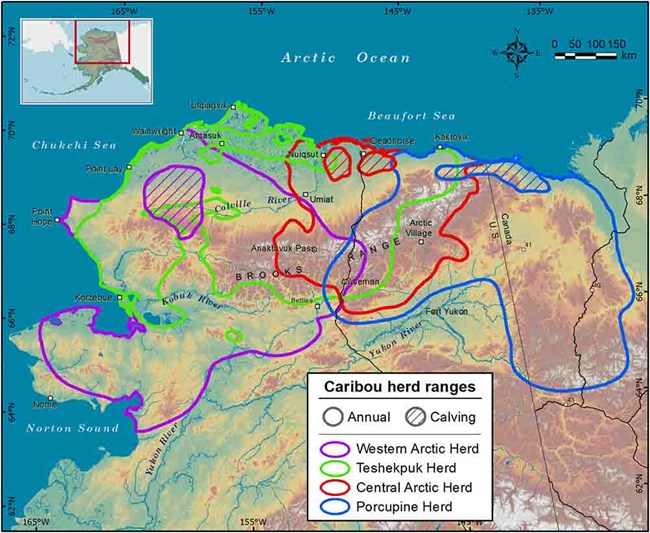Last updated: August 24, 2020
Article
Home, home on your range?

Caribou show high fidelity to their calving areas and this trait has been used to define the more than 30 herds in Alaska. Prior to long-term GPS collar studies, conventional wisdom dictated that it was very rare for caribou to switch from one herd to a different one. Indeed, in the 1980s and 1990s, researchers reported that “interchange between calving grounds has not yet been unequivocally documented” and “no credible evidence that the interchange of groups of caribou between herds has ever occurred in Alaska.” Caribou, together with reindeer (which is the name used for the same species in Eurasia), are found across the entire Arctic. If caribou were to have extreme fidelity to their calving grounds, new calving areas (and thus herds) could not be established, and the species would not likely be found across the northern hemisphere. So, the idea that caribou never interchanged with other herds seems somewhat doubtful. In the 2000s, genetic analyses proliferated and showed little differentiation between adjacent herds, leading to further questions about interchange among caribou herds. Researchers from ABR, Inc, Alaska Department of Fish and Game, National Park Service, and North Slope Borough brought together long-term caribou distribution data for all four of Alaska’s Arctic herds to study interchange among them. They documented caribou switching herds from all four herds, but it primarily occurred between adjacent herds. Interestingly, a large majority of the switching events occurred from caribou going from the two smaller herds (Teshekpuk Caribou Herd and Central Arctic Herd) to the two larger herds (Western Arctic Herd and Porcupine Herd). There was little interchange from the large herds to the small herds. The amount of interchange was higher than expected for the smaller herds (~8% of female caribou per year switched herds) and around 1% for the larger herds. The was considerable variability from year to year, with the small herds reaching 13-37% in the years with the greatest switching and the large herds reaching 3-6%. Understanding the amount of interchange among herds has important implications for estimating the number of caribou in each herd, composition counts (sex ratio), harvest regulations, and the ecology of the species. These novel results should help to improve the management of caribou across Alaska’s Arctic.
Interchange and Overlap Among Four Adjacent Arctic Caribou Herds
Abstract
Barren ground caribou (Rangifer tarandus granti) are distributed in herds that seasonally use specific geographic regions within an annual range, with varying levels of fidelity during different periods (e.g., calving, insect relief, wintering). As a result, caribou management is generally tailored to individual herds that often range across administrative boundaries. Herd ranges can shift over time, seasonal ranges of adjacent herds often overlap, herds merge, and there is often little genetic differentiation among adjacent herds. If substantial herd interchange occurs, it would have important management implications by influencing estimates of herd size, herd composition, and harvest rates. We compiled satellite telemetry data from 2003-2015 for four large Arctic caribou herds to quantify herd interchange rates. We calculated a metric of herd interchange based on the relationship of caribou locations to typical weekly herd ranges (all years combined) and the distance to other radio‐collared caribou from each of the four herds (year specific). Although herd membership cannot always be clearly defined based on location, this metric provides an objective measure of the strength of evidence of herd membership that can be used to make comparisons among herds and time periods. We also calculated herd overlap and quantified how it varied throughout the year. Herd interchange was rare in the two larger herds, generally occurring when caribou overwintered with an adjacent herd, whereas herd interchange from the two smaller herds was more frequent and could last longer than a year. Although sample sizes were limited, there were no clear patterns in herd interchange with year or annual herd size. The two smaller herds had large seasonal overlap with adjacent herds, suggesting that herd interchange may be related to spatiotemporal herd overlap and relative herd size. Our results can help managers understand herd interchange and overlap to make management decisions, interpret research results, and develop more accurate population models.
Prichard, A. K., L. S. Parrett, E. A. Lenart, J. R. Caikoski, K. Joly, and B. T. Person. 2020. Interchange and overlap among four adjacent Arctic caribou herds. Journal of Wildlife Management 1-15.
